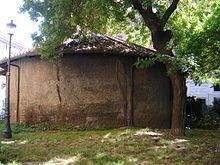 | ||
The Gardens of Maecenas, built by Gaius Maecenas, an Augustan-era patron of the arts, were the first gardens in the Hellenistic-Persian garden style in Rome. He sited them on the Esquiline Hill, atop the Servian Wall (agger) and its adjoining necropolis, near the gardens of Lamia.
Contents
Site
Difficulty exists when attempting to reconcile the indications in ancient literature in order to determine the exact locations of places noted therein. Topographers disagree about whether the gardens lay on both sides of the Servian Wall and both north and south of the porta Esquilina. Many of the burial pits of the ancient necropolis have been found near the north-west corner of the Piazza Vittorio Emanuele, that is, outside the porta Esquilina and the Servian Wall and north of the via Tiburtina vetus. Probably, the horti extended north from that gate and road, on both sides of the agger.
Facilities
Maecenas is said to have been the first to construct a swimming bath of hot water in Rome. It may have been in the gardens. A purchase of the horti Maecenatiani by Fronto is noted later in ancient litereature. Whether they were the former gardens of Maecenas, or merely called so for some other reason, is unknown.
A domus Frontoniana mentioned during the twelfth century in the topographical guide to Rome by Magister Gregorius, also may refer to these gardens.
The gardens contained terraces, libraries, and other aspects of Roman culture, and reportedly, incurred the displeasure of Seneca the Younger. It is likely that the gardens contained the Auditorium of Maecenas.
History
The gardens became imperial property after Maecenas's death. Tiberius lived there after his return to Rome in 2 AD. Nero connected them with the Palatine Hill via his Domus Transitoria, and viewed the burning of that palatial house from the turris Maecenatiana This turris probably is the molem propinquam nubibus arduis ("the pile, among the clouds") mentioned by Horace.
